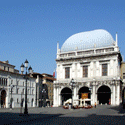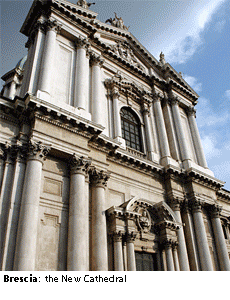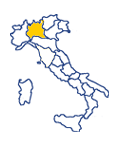
Brescia Hotels

Reserve Brescia Hotels: save up 70% on rooms!
Compare offers & book on line at hotel's web sites. |
|

|
|
Brescia Guide Italy
Churches and Museums
|
|
|
|
|
Churches and Museums
- The Duomo Vecchio or “Rotonda”: a Romanesque building on a circular plan surmounted by a tambour with conical roof. Its interior consists of a central space formed by eight pilasters that support a majestic dome. From the lower level, one descends to the crypt of San Filastro, constructed using Roman and Byzantine materials from the preceding basilica. The Rotonda contains interesting paintings by Romanino and Moretto and the sarcophagus of Bishop Berardo Maggi (1308).
- The Duomo Nuovo: construction began in 1604 but was not finished until 1825, when the dome was completed. Due to the slow pace of construction, its style is anything but homogeneous: one notices this immediately in the majestic façade, which has a Baroque lower part and is Neoclassic over the portal. The interior has a Greek cross plan with columns and pilasters supporting an 80-meter high dome. The church preserves many sculptures and paintings from the Renaissance on.
- San Francesco: an exquisite example of a Franciscan monastery, constructed in the 13th century in a late Romanesque style. Its simple façade encloses a splendid rose window. Even the interior is characterized by a simple style, but it preserves important works, frescoes and paintings including a masterpiece by Romanino. The splendid cloister built in 1394, with its red marble columns, is also worth a visit.
- Santi Nazario e Celso: This church is worth a visit just for one masterpiece it contains: the Averoldi polyptych by Titian.
- Santa Maria dei Miracoli: this church is considered a jewel of Lombard Renaissance sculpture. It was constructed to celebrate a miraculous image of the Madonna tat was painted on the wall of a nearby house. The sacred image is now kept in the church's apse. The façade was decorated by master sculptors who worked on the construction of the Loggia during the same period.
- Museo della Città - Monastery of Santa Giulia: this incredible museum is one of the most important complexes of the early middle ages in Northern Italy. Founded in 753 by the Lombard King Desiderio, the monastery was expanded several times until the Renaissance. The complex contains the Basilica of San Salvatore, of Lombard origin, the Church of Santa Giulia, the Church of Santa Maria in Solario, which houses the Treasure of Santa Giulia, and three Renaissance cloisters. Three Roman villas were discovered under the larger cloister, the Domus dell’Ortaglia. The monastery area was acquired by the Municipality, which has turned the Church of Santa Giulia into the “Museo della Città” where one can follow the history of Brescia from the Bronze Age through to the Renaissance. The museum regularly hosts large art shows.
- Museum of Ancient Arms: the museum is located in the Castello di Brescia and is one of the most important collections of ancient arms in Europe. The visitor will find himself surrounded by over 500 weapons and armor fabricated in Italy and Europe from the 15th to the 18th centuries. There are very rare pieces, masterpieces of technique and refinement and many made in Brescia. The museum also contains the remains of a Roman temple found during excavations.
- Pinacoteca Civica Tosio-Martinengo: this is one of the most important Italian painting collections. The works on display range from the 13th to 18th centuries. The main nucleus consists of paintings by Renaissance Brescian masters such as Foppa, Romanino, Moretto and Savoldo; to these are added masterpieces by Raffaello, Paolo Veneziano, Lotto and others. The Pinacoteca also hosts many works coming from city palazzi and churches. The museum organizes extremely important art exhibits on a regular basis.
- Museo del Risorgimento: the museum traces the history of Italian Unification from the end of Venetian domination until 1870. The collection contains a great many canvases, prints, letters, announcements, decrees, coins and knickknacks from that period.
Photos courtesy of: Provincia di Brescia – Assessorato Turismo, Comune di Brescia – Servizio Turismo
Go to directories of the Web Sites
|
|
|
|
|
Acquista la tua visibilità su Travel Plan
|
|
|
|




